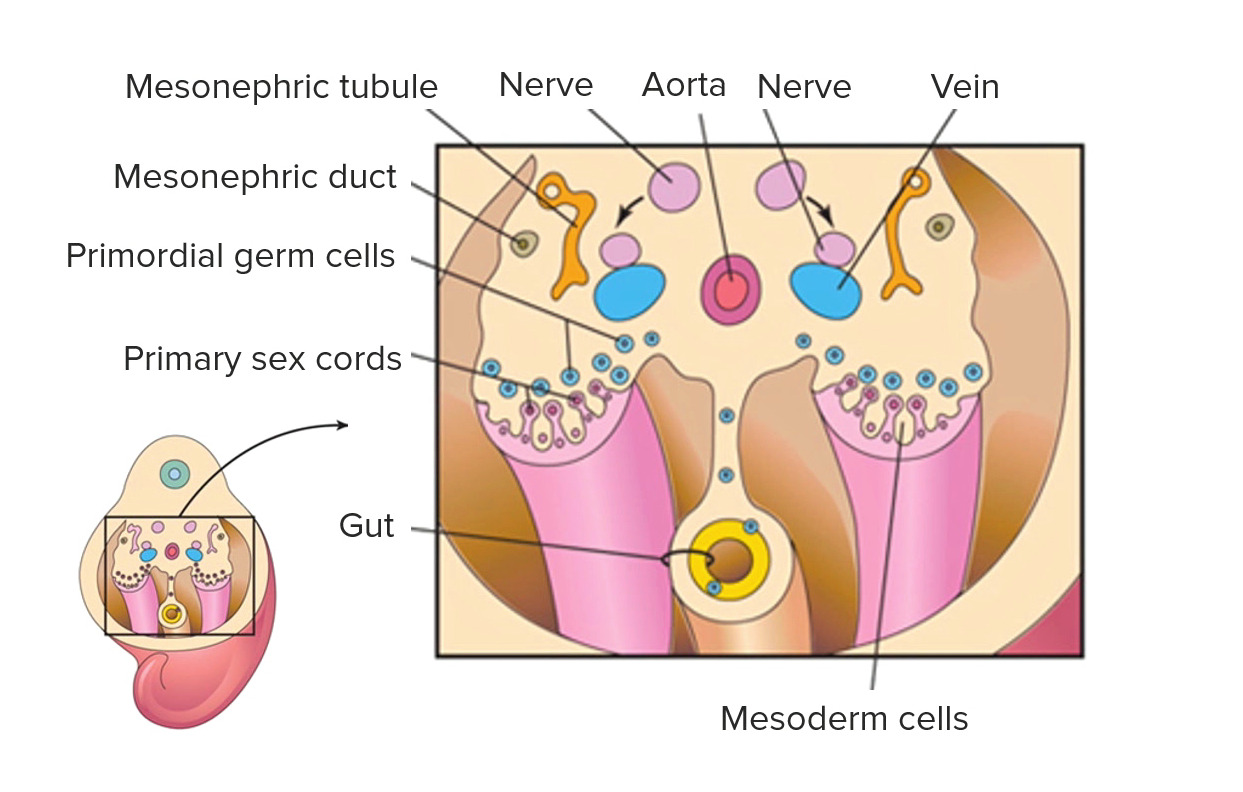Playlist
Show Playlist
Hide Playlist
Spermatogenesis
-
Slides 09-58 Spermatogenesis and Oogenesis.pdf
-
Download Lecture Overview
00:01 We will now continue our discussion of germ cell development by looking at spermatogenesis and oogenesis, which produce germ cells that are capable of fertilizing and being fertilized. 00:11 The primordial germ cells involved in spermatogenesis move into the testes very early, but do not become capable of fertilizing until well after puberty when spermatogonia are going to become active, divide and produce more primary spermatocytes. 00:28 At this point, these divisions are mitotic and produce identical copies of the parent cell leading to the primary spermatocyte, which is the largest germ cell in the body. 00:38 As we enter meiosis, we're going to produce two secondary spermatocytes and then another round of meiosis brings us to spermatids. 00:48 These spermatids are not yet capable of fertilizing an egg. 00:52 For that to happen they need to mature into spermatozoa and that process is going to be called spermiogenesis. 00:59 So we call it spermatogenesis as the entire process where spermiogenesis is the process by which a spermatid becomes a spermatozoa. 01:09 In the process of spermiogenesis, we get what I refer to as the classic appearance of spermatozoa. 01:16 The cell will extend a flagellum off the back and in front of the nucleus the acrosome will form which allows it to penetrate the protective layer around the egg and actually get to the egg's plasma membrane to fertilize it. 01:31 As this is occurring, cytoplasm is being shed from the spermatid and it's being'having its mitochondria get concentrated in a mitochondrial sheath around its mid-piece. 01:43 So the mid-piece contains the powerhouse of the spermatozoa, which allows the flagellum to move and keep the sperm mobile and moving forward once it's entered the female reproductive tract. 01:54 As it sheds, all of its cytoplasm except for the little bit that's maintaining the nucleus, the acrosome, the mitochondrial sheath and the tail, the nearby cells that are supporting the spermatozoa are going to absorb those residual bodies. 02:09 As spermatozoa have come into existence, we're gonna be moving from the periphery of the spermatic tract into the lumen. 02:20 So as spermatogonia divide and enter meiosis, they're gonna move further and further away from the basement membrane. 02:28 So the seminiferous tubules are where they will be shed and we move from spermatogonia to primary spermatocytes, to secondary spermatocytes, and thereafter to the spermatids once the second round of meiosis has been completed. 02:42 Thereafter, the tails of the maturing spermatozoa will be hanging out in the lumen. 02:48 They're not yet mobile, but will be shed into the lumen of the seminiferous tubules to be transported down the ductus deferens, and eventually to the male urethra. 02:57 Testosterone is a necessary hormone for the process of spermatogenesis and spermiogenesis to proceed effectively. 03:04 Leydig cells, which are located just outside the seminiferous tubules, secrete testosterone and the Sertoli cells, which are within the seminiferous tubules and support the maturing spermatozoa will concentrate that testosterone to over a hundred times the concentration found anywhere else so that the spermatids can become a spermatozoa and then be shed and effectively make the male fertile.
About the Lecture
The lecture Spermatogenesis by Peter Ward, PhD is from the course Conception, Implantation and Fetal Development.
Included Quiz Questions
Once active, spermatogonia divide mitotically to create what type of cell?
- Primary spermatocytes
- Secondary spermatocytes
- Spermatozoa
- Sertoli cells
- Leydig cells
Testosterone is necessary for maturation of spermatids to spermatozoa. Which cells are essential for the concentration of testosterone?
- Sertoli cells
- Leydig cells
- Spermatocytes
- Spermatozoa
- Spermatid
Customer reviews
5,0 of 5 stars
| 5 Stars |
|
1 |
| 4 Stars |
|
0 |
| 3 Stars |
|
0 |
| 2 Stars |
|
0 |
| 1 Star |
|
0 |
Good succinct intro to spermatogenesis; covers all the basics upon which to build a foundation.




